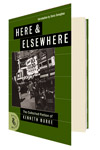I feel a little cheated no one ever told me this stuff was out there. I’d heard the name Kenneth Burke in connection with his career as a literary critic, but I had no idea there was a fictional oeuvre attached to that name—let alone a body of work this masterful and broad. Burke’s telegraphic bio might be full of illustrious fellowships and titles like The Rhetoric of Religion: Studies in Logology, but in this book, even the author’s bio is avant-garde. In 1918, Burke dropped out of college; in 1924, he published his first collection of stories; in 1925, he published his translation of Death in Venice; in 1931, his first volume of criticism; in 1932, his first novel; in 1933, he left his wife for her sister and became the music critic for the Nation.
This book—collecting in one place the previously published volumes Towards a Better Life (a short novel) and The White Oxen (stories), as well as a handful of prose poems and previously uncollected short fiction—is little short of astounding. As one might expect from a scholar of rhetoric, Burke’s prose is impeccable and, for the most part, crystal clear, but his imagination is that of a modern Blake. The collision of hyperarticulacy and ecstasy produces a voice so original as to seem utterly new.
His mastery of the English language allows him to compose pieces that succeed as philosophy, domestic drama, myth, hallucination, or pure music—usually succeeding at several at once, sometimes becoming just one or two, and sometimes, thrillingly, swerving between all of them in baffling succession. “Let us build a great hippopotamus,” begins the coda to one otherwise realistic story—apropos nothing whatsoever—“to the glorification of our century.”
Towards a Better Life is the longest piece in this collection, a sort of one-sided epistolary novel with a flamboyantly solipsistic narrator. Ostensibly, the story is about the narrator’s relationship with the ex-friend to whom the epistles are addressed, but the discourse seldom escapes the confines of his own mind; instead of relying upon external images or events to explain his emotional state, the narrator writes in carefully balanced aphorism and analysis, something like Samuel Beckett’s The Unnamable from the point of view of Jane Austen.
When the narrator finally renders a discrete image, it radiates pathos and significance. At the end of a particularly affecting chapter, he retells an acquaintance’s visit to a general store in the country:
He recalled that a kitten lay asleep, its ear tickled by the rim of a spittoon; he described the crack of billiard balls, in an adjoining room, at moments foreign to the rhythms of the orchestra [on the radio]; he mentioned a bell which, installed at the door to announce the entrance of new patrons, gratuitously marked their exit.
Reading passages like that, I find myself wishing this book were required reading for every living fiction writer. It’s become fashionable to do up a piece in the drag of classical learning, but here’s somebody totally immersed in classical learning, who can fiddle around with highfalutinisms for a hundred pages without sounding a single sour note.
Finally, a hat-tip to the publisher for giving this work the treatment it deserves—Denis Donoghue, one of the best critics working today, supplies a fascinating introduction, and an extensive Publisher’s Note helps to fill in the gaps of Burke’s sporadic, idiosyncratic, and yet totally essential career as a fiction writer.





